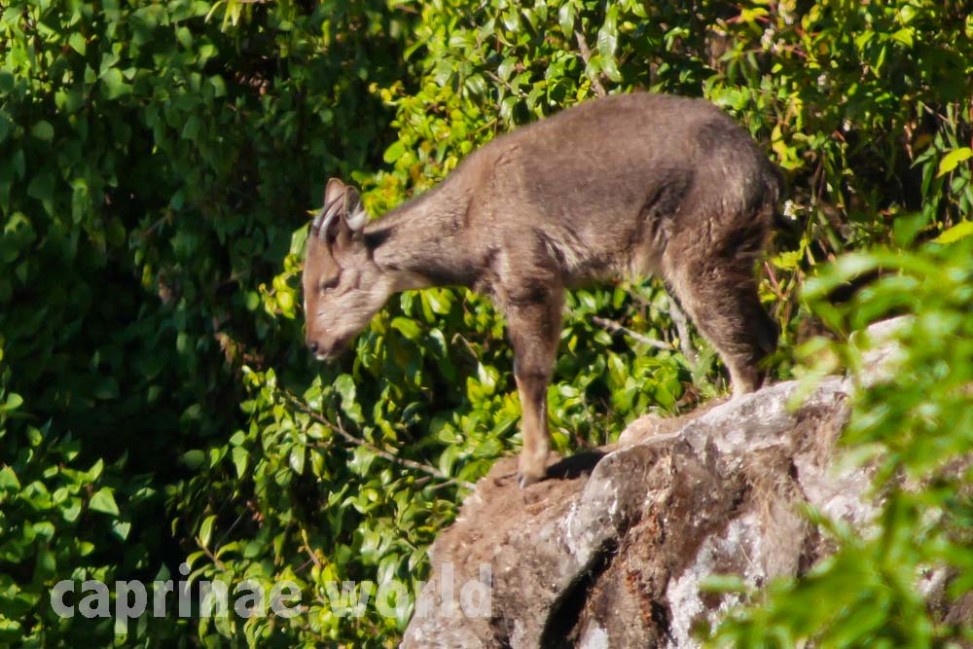The Burmese Goral is maybe the most inconspicious species of the gorals. It appears smallest in size, with a less contrasting pelage.
Names
English common names: Burmese Goral (3), Evan’s long-tailed Goral (1), Burmese Long-tailed Goral, Thai Goral, Gray long-tailed Goral (5)
Czech (name proposed): Goral barmský (6)
German: Burma-Goral (3)
French: Goral d‘ Evans (3)
Spanish: Goral de Birmania (3)
The generic name was originally spelled Naemorhedus, but the spelling Nemorhaedus, despite being an unjustified emendation, is in „prevailing“ usage and is used here as well. (3)
Taxonomy
Urotragus evansi Lydekker, 1905, Burma (Myanmar)
Type locality: Mt. Victoria, Arakan, Myanmar (4)
The Burmese Goral was previously classified as a subspecies of N. griseus. (3) However, the two vary significantly.
The Burmese Goral differs from the Chinese Goral by: (4)
– its much smaller size
– its extremely short hair
– on average lighter colour
– less contrasting colour of the tail and the face
Distribution
India – Northeast (Assam, Arunachal Pradesh, Meghalaya, Nagaland, Manipur and Mizoram); Myanmar (western and eastern borders – absent from the central lowland parts); Thailand – North-West; China (Yunnan) (6)
General discription
length / head-body: 50-70 cm (3)
shoulder height: 50-70 cm (3) – these measures compared to the length seem doubtful, but no other dimensions are available.
weight: 20-30 kg (3)
tail: 12-18 cm (3)
horn length: 15 cm – males; 10 cm – females (3)
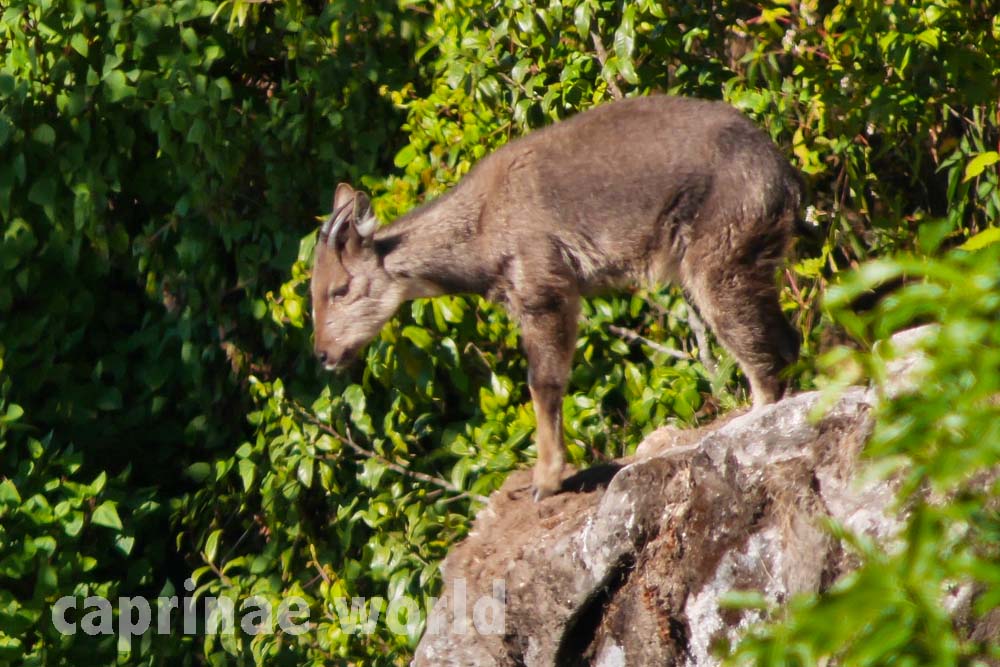
Burmese goral in winter coat at Doi Inthanon NP, Thailand. Note the large throat patch. Photo by Smith Sutibut
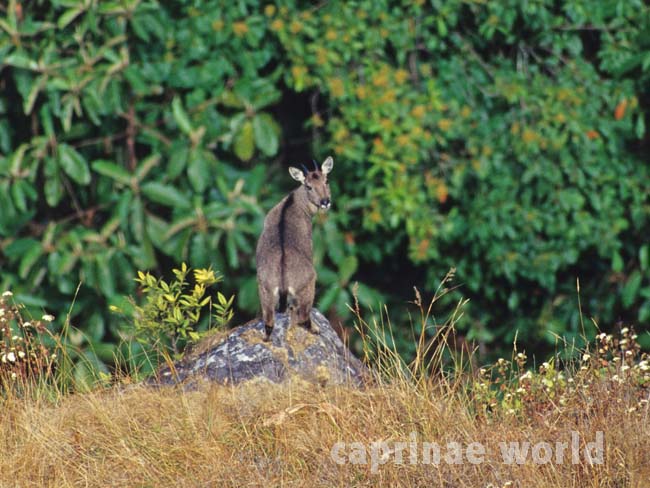
Burmese goral (Nemorhaedus evansi), Kew Mae Pan, Doi Inthanon National Park, Thailand. Adult female in winter coat. Note: The prominent dorsal stripe – which is always present in adults (6); small, whitish rump patch and darker nose; white upper lips. Photo by Smith Sutibut
Pelage in adult Burmese Goral
| summer | winter | |
| body | very light, fawn or somewhat brown (4) | bit darker, more of a brownish-grey (6) |
| underside | pale gray-fawn (3), almost white (6) | unlike the summer coat, coloured identically to the rest of the body; only the pubic region is light cream. (6) |
| limbs | usually completely cream or light ochre in colour around the entire circumference, creating a kind of stockings (6); with thick black line down the front (4) | distal parts of the limbs (lower end) are ochre |
|
nape and dorsal stripe
|
usually prominent and dark brown (4) – hairs forming the nuchal stripe are somewhat extended, creating a short mane (6) | always with nuchal and dorsal stripe (6) |
| ridge of nose and forehead | coloured in a strikingly darker brown tone; separated from the lighter coloured cheeks by a clearly defined line (6) | similar to the summer coat (6) |
| throat patch | light, very large (6) | deep cream colour (6) |
| tail | mostly dark brown (4), similarly-coloured to the dorsal stripe (6) | dark brown-coloured (6) |
| rump patch | narrow, light coloured (6) | – |
compiled mainly from Hrabina (2015) and Groves and Grubb (2011)
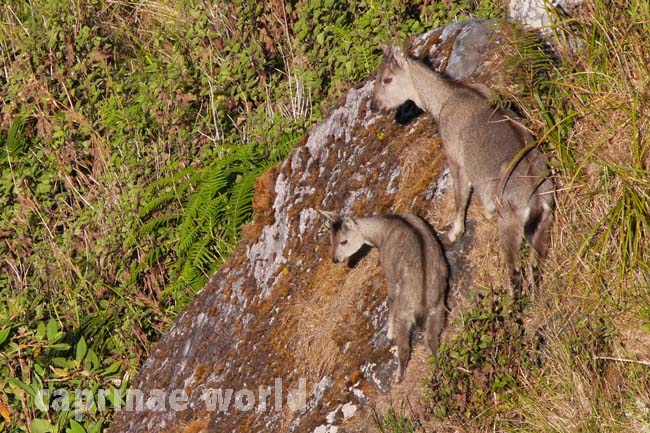
Burmese goral, female and young, in winter coat at Doi Inthanon NP, Thailand. Note: darker tail in female, lighter tail in young; dark hair crest between ears of young; lighter cheeks. Photo by Smith Sutibut
Pelage in young Burmese Goral (seasons unconsidered) – (6)
body: very light grey
lower legs: light colour quite reduced
nuchal and dorsal stripe: not as prominent as in adults or may be lacking altogether
tail: usually coloured identically to the body
crest between ears: very conspicuous, dark brown hair, disappears in adults
Horns
In both sexes the horns of Burmese Goral are strikingly short – around 15 cm in males, only up to 10 cm in females. In both sexes the horns are also noticeably slender. They are clearly backward-curved in males, and visibly straighter in females. Males’ horns are evenly shallow-ribbed, the number of notches no greater than 5, whereas the females’ are almost smooth. (6)
Habitat
The Burmese Goral occurs in rocky, steep terrain with tall vegetation cover, often on slopes over 60°. In one area they were found at elevations of 1600-1970 m. (3)
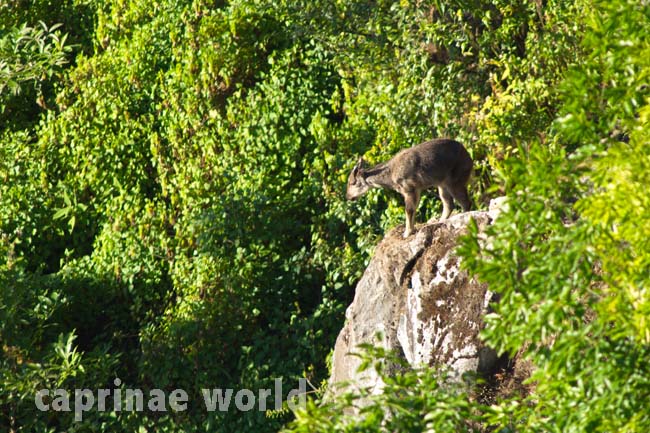
The Burmese Goral, hear at Doi Inthanon NP, Thailand, likes rocky, steep terrain with tall vegetation. Photo by Smith Sutibut
Mortality / Predators
Dhole, leopard, lynx, tiger (5)
Food and feeding
Probably primarily a diet of grasses. (3)
Breeding
Gestation: probably 180 days (3)
Young per birth: twins are rare (3)
Activity patterns
The Burmese Goral is likely crepuscular as in other gorals. (3)
Movements, home range and social organisation
Male Burmese Goral are solitary and likely territorial like other gorals. (3) There is a single local density estimate of ca. 5 goral/km² in Om-Koi Wildlife Sanctuary, Thailand (Lovari and Apollonio, 1993). (2)
Conservation Status / threats
According to IUCN the Burmese Goral is classified as vulnerable (under N. griseus). (2) Poaching, deforestation, and agricultural development are major causes of declines and fragmentation of Burmese Goral populations. Status of most populations is unclear because of lack of monitoring. Lack of enforcement of game and forest extraction laws is a major concern. (3)
Trophy hunting
No entries found. Most probably there is no opportunity for foreigners to hunt Burmese Goral.
Ecotourism
According to Bruce Kekule – brucekekule.com – Doi Inthanon National Park, Thailand, is a „great place for these amazing animals“, some 80 kilometers south of Chiang Mai. (7)
Literature Cited
(1) Damm, Gerhard R. and Franco, Nicolás, 2014: The CIC Caprinae Atlas of the World – CIC International Coucil for Game and Wildlife Conservation, Budakeszi, Hungary in cooperation with Rowland Ward Publications RSA (Pty) Ltd., Johannesburg, South Africa.
(2) Duckworth, J.W., Steinmetz, R. & Rattanawat Chaiyarat. 2008. Naemorhedus griseus. The IUCN Red List of Threatened Species 2008: e.T14303A4430834. http://dx.doi.org/10.2305/IUCN.UK.2008.RLTS.T14303A4430834.en. Downloaded on 30 January 2017.
(3) Wilson, D.E. and Mittermeier, R.A. [eds], 2011: Handbook of the Mammals of the World. Vol. 2. Hoofed Mammals. Lynx Edicions, Barcelona.
(4) Groves, Colin and Grubb, Peter, 2011: Ungulate Taxonomy. The John Hopkins University Press.
(5) Castelló, José R., 2016: Bovids of the World – Antelopes, Gazelles, Cattle, Goats, Sheep, and Relatives. Princton University Press.
(6) Hrabina, Petr: „A new insight into the taxonomy and zoogeography of recent species of goral (Nemorhaedus, Bovidae, Ruminantia)“, Gazella 42, 2015, Zoo Praha
(7) http://brucekekule.com/?s=Doi+Inthanon&x=21&y=11

